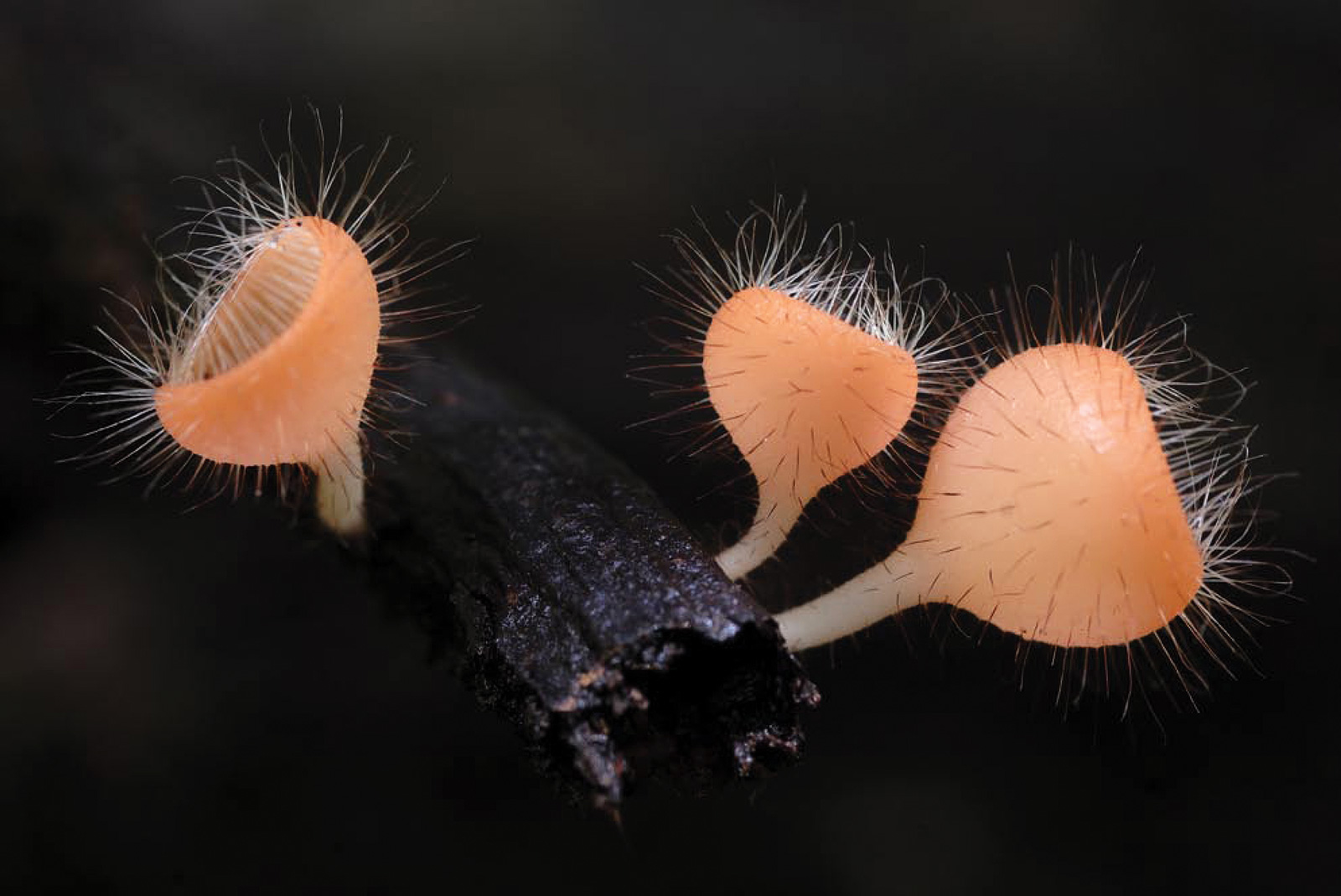CAMBODIA WILDLIFE
From our print archive: At first glance, Cambodia’s rainforests may seem bereft of wildlife, but a closer looks reveals a profusion of tiny and often unique creatures
WHY WE WROTE THIS: Because the Cambodian jungles contain a multitude of tiny wonders
JEREMY HOLDEN
OCTOBER 4, 2019
Where the small things are

The bizarre cup fungus Trichostoma cookieana appears during the rainy season, growing out of rotting twigs on the forest floor. This group was seen on Mt. Samkos in Pursat Province. Photo: Jeremy Holden
Editor’s note: Destruction of ecosystems; loss of biodiversity. These clinical phrases do little to make us realise just how rich the worlds we stand to lose really are. But in Cambodia’s dwindling rainforests, devastated by decades of deforestation, whole universes take shape beneath the shade of a single flower. In 2009, photographer Jeremy Holden turned his lens towards some of the Kingdom’s most beautiful – and fragile – flora and fauna. Now, for the first time, you can read the story online.
The topic of “jungle creatures” conjures up images of majestic tigers, lordly elephants, giant snakes and rampant monkeys, creatures known to scientists as “mega fauna”.
In the Cambodian rainforest, however, seeing its creatures, even finding signs that they are present, is a challenging problem because of their size. This rainforest is nothing like the African savannah, where large animals are plentiful.
In the forest, the larger mammals are scarcer – having a naturally lower density – and shyer.
Many researchers studying rainforest mammals, such as tigers or species of rhinoceros, never see their subjects, but rather conduct their studies using devices such as trip-cameras.
Given all that it might seem a waste of time journeying to one of Cambodia’s remote rainforests in search of wildlife.
This, however, is not the case. The real wonders, at least the ones most likely to inspire wonder in those that have ventured into the country’s forests, are the abundance of smaller creatures.
Tropical rainforests exhibit some of the highest diversity of species found in any ecosystem. Not only are there more plants and trees, but also a myriad of species that exist on and among this botanic paradise.
A contemporary debate gives some idea of how diverse this ecosystem is: there are currently about 2 million different species on Earth.
Scientists argue about how many remain to be discovered – 10 million, 20 million? Some even push the number as high as 30 million. But everyone agrees that the vast majority of these as-yet-undiscovered species are probably in tropical rainforests and are most likely insects.

The orchid Habenaria rhodochelies grows on the dark, shadowy cliffs beside waterfalls in the rainforests of Mondulkiri. Photo: Jeremy Holden

Dragonflies and damselflies are a common feature of Cambodian waterways. The more interesting and unusual species occur in the rainforest, especially along small streams. This jewel-like Libuella species was seen in O’Som commune, Veal Veng district. Photo: Jeremy Holden

Cambodia has many species of snake, including the Reticulated Python – the world’s longest snake, and the King Cobra – the world’s largest venomous snake. The majority, however, are harmless, to humans at least. This small species is the slug snake Pareas carinatus, so-called because it feeds mostly on snails and slugs. It can commonly be found in the rainforests of Cambodia and here on Koh Kong island. Photo: Jeremy Holden

There are over 60 species of frog in Cambodia, some of them occurring nowhere else. This Philautus Cardamonus was discovered at 1717 metres on the summit of Mount Samkos in the Cardamom Mountains, and has to date been seen nowhere else. Many frogs native to high altitude forests are becoming extinct due to global warming and the consequent drying out of these typically moist areas, such as here in Pursat province. Photo: Jeremy Holden

This larva from the moth family Limacodidae is equipped with spines that are tipped with poison. The colour acts as a warning to potential predators that it will not make a tasty meal. Location – Cardamom Mountains. Photo: Jeremy Holden

Sapria poilanei is a strange terrestrial flower belonging to the Rafflesia family. It was first described from Cambodia’s Cardamom Mountains. The body of the plant has no leaves but rather lives fungus-like within vines, stealing all the nutrients it needs to survive and to produce these opulent flowers. Photo: Jeremy Holden

A leaf insect of the genus Phyllium. These particular insects are leaf-eaters themselves, but have evolved an almost perfect camouflage by adopting a leaf-like form. The ruse is perfected to the extent of mimicing old and damaged leaves, thereby avoiding inadvertent consumption by other leaf-eating creatures. They can be found in the lowland forests of Botum Sakor National Park in southern Cambodia. Photo: Jeremy Holden

The spectacular Acanthosaura is an agamid lizard found in the hill forests of southern Cambodia. It can be seen perched in low trees or sometimes on the ground, where it hunts for earthworms and insects. This particular species appears to be a form of Acanthosaura crucigera. Photo: Jeremy Holden

A large cricket and ants being slowly dissolved into an insect soup in the pitcher of a Nepenthes plant in the Cardamom Mountains. Photo: Jeremy Holden
Although creepy crawlies probably contribute most to the species diversity seen in rainforests, there is a wealth of other strange and wonderful things hopping around. In Cambodia there are hundreds of species of orchid, thousands of types of fungi, more than 60 species of frog and more than twice that number of reptiles.
Knowing that tigers and elephants inhabit a forest in which one is walking gives a sense of primal awe. But it is in the smaller things – the dazzling insects, strange flowers and reptiles – that create the real wonder and delight. The images here were captured in rainforests across Cambodia and hopefully attest to the wonders of the many small things living there.

No comments:
Post a Comment